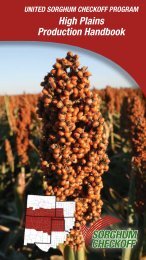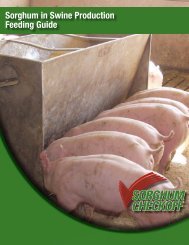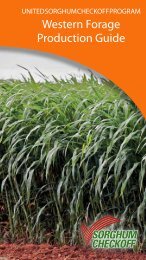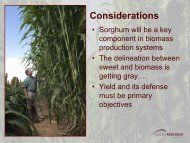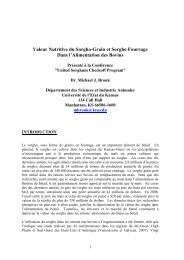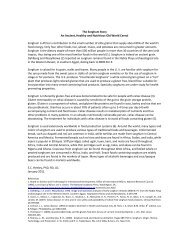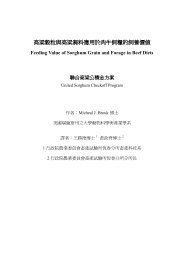Sorghum in Poultry Production Feeding Guide - Sorghum Checkoff
Sorghum in Poultry Production Feeding Guide - Sorghum Checkoff
Sorghum in Poultry Production Feeding Guide - Sorghum Checkoff
Create successful ePaper yourself
Turn your PDF publications into a flip-book with our unique Google optimized e-Paper software.
Feed<strong>in</strong>g Value<br />
poultry (as measured by TMEn). However, the average prote<strong>in</strong> content of sorghum at<br />
the time of this publication <strong>in</strong>dicates that sorghum conta<strong>in</strong>s more prote<strong>in</strong> than corn.<br />
Table 2 shows the am<strong>in</strong>o acid composition of sorghum and corn as published <strong>in</strong><br />
the NRC (1). The am<strong>in</strong>o acid profile of sorghum compares favorably to corn, and is<br />
complementary to the am<strong>in</strong>o acid profile of soybean meal, which is often used as a<br />
prote<strong>in</strong> source <strong>in</strong> poultry rations worldwide. Although the lys<strong>in</strong>e and methion<strong>in</strong>e levels<br />
are slightly lower for gra<strong>in</strong> sorghum compared to corn, the current availability of these<br />
am<strong>in</strong>o acids <strong>in</strong> synthetic form for supplementation <strong>in</strong>to least cost rations lessens the<br />
importance of slight differences <strong>in</strong> am<strong>in</strong>o acid content.<br />
Most poultry producers formulate feeds today us<strong>in</strong>g digestibility data. Table 3 shows<br />
the availability of am<strong>in</strong>o acids for poultry <strong>in</strong> gra<strong>in</strong> sorghum from the NRC (3). The<br />
critical am<strong>in</strong>o acid, lys<strong>in</strong>e and methion<strong>in</strong>e, are slightly lower <strong>in</strong> sorghum compared to<br />
corn. However, s<strong>in</strong>ce these data are equalized based on prote<strong>in</strong> content, the actual<br />
am<strong>in</strong>o acid available for growth would be higher for sorghum compared to corn.<br />
Producers evaluat<strong>in</strong>g the choice of gra<strong>in</strong> sorghum as an alternative cereal gra<strong>in</strong><br />
should carefully consider the source of nutritional values assigned to the nutrients<br />
from sorghum <strong>in</strong> their feed formulation software. For example, it is likely that some<br />
of the data resources used to compile the tables <strong>in</strong> the NRC (3) are not accurate or<br />
precise today, because some data was based on tann<strong>in</strong> conta<strong>in</strong> varieties that reduced<br />
nutrient value. S<strong>in</strong>ce much of the data was tabulated, new varieties of gra<strong>in</strong>s<br />
of all types, <strong>in</strong>clud<strong>in</strong>g sorghum, have been <strong>in</strong>troduced. Gra<strong>in</strong> sorghum exported from<br />
the U.S. today will be of much higher nutrient quality than <strong>in</strong> years past. If concerned<br />
about possible tann<strong>in</strong> levels <strong>in</strong> sorghum obta<strong>in</strong>ed <strong>in</strong> other places around the world, a<br />
simple test can be conducted to determ<strong>in</strong>e the presence of tann<strong>in</strong> (4,5).<br />
“...sorghum<br />
conta<strong>in</strong>s more<br />
prote<strong>in</strong> than<br />
corn.“<br />
Table 1. Composition of <strong>Sorghum</strong> & Corn for <strong>Poultry</strong> Feeds (As Fed) (NRC, 1994)3<br />
<strong>Sorghum</strong>, <strong>Sorghum</strong>,<br />
Corn<br />
8-10% Prote<strong>in</strong> more than 10% prote<strong>in</strong><br />
Dry Matter (%) 87 88 89<br />
MEn (kcal/kg) 3288 3212 3350<br />
TMEn (kcal/kg) 3376 --- 3470<br />
Prote<strong>in</strong> (%) 8.8 11.0 8.5<br />
Ether Extract (%) 2.9 2.6 3.8<br />
L<strong>in</strong>oleic Acid (%) 1.13 .82 2.20<br />
Crude Fiber (%) 2.3 2.3 2.2<br />
Total Calcium (%) .04 .04 .02<br />
Non-Phytate Phosphorus (%) .30 .32 .28<br />
Phosphorus (%) --- --- .08<br />
5



